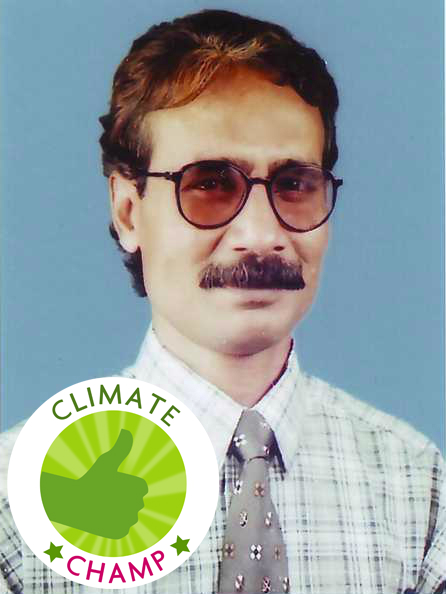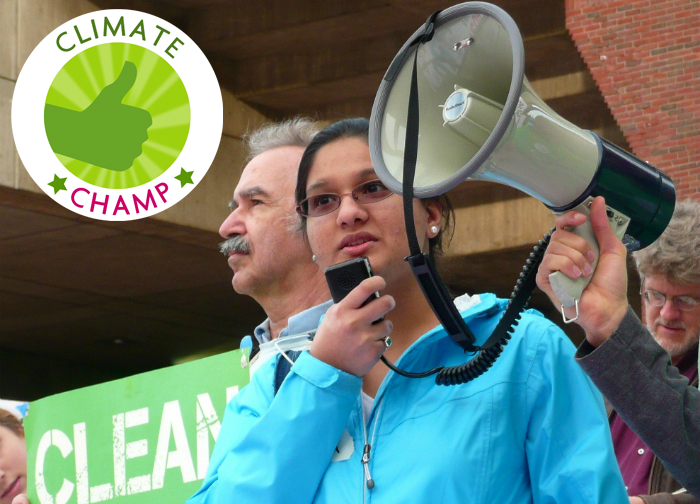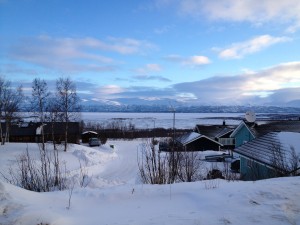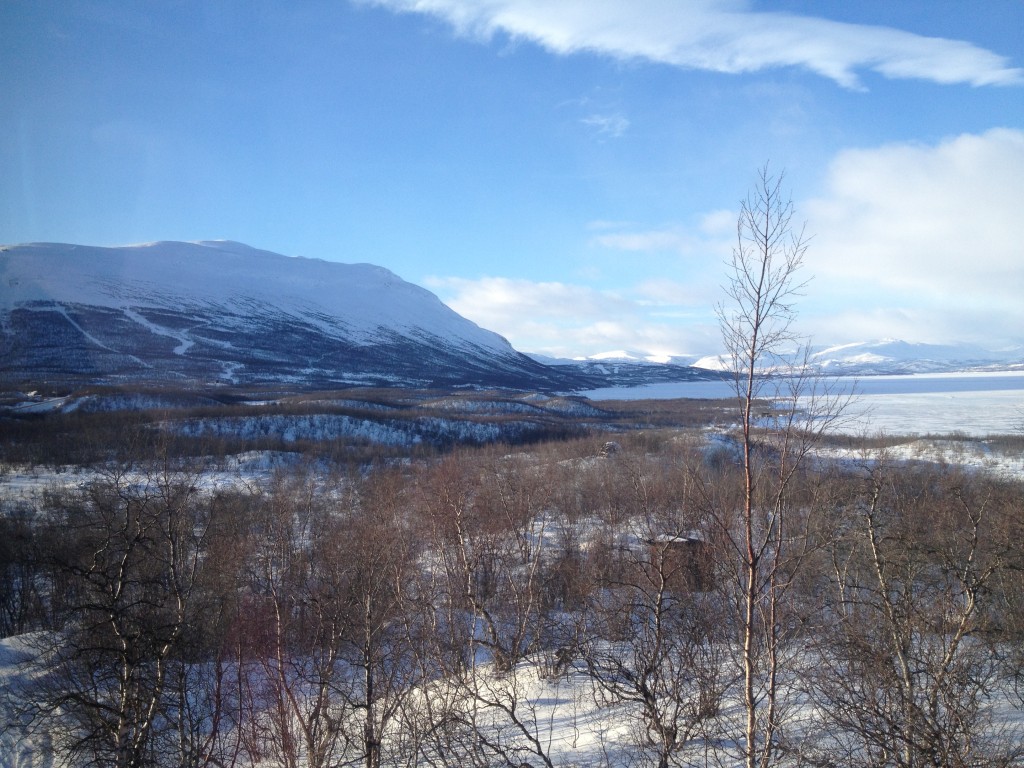Search Results for Tag: climate change
Exploring the North – Visible signs of climate change
Almost in the middle of nowhere, where just a few houses stand between trees around the lake, there is kind of a research nest. Scientists from different countries live and work together in Abisko, Sweden, to investigate the impact of climate change in the Arctic region.
That is especially feasible, as the research station is located North of the polar circle. The Arctic region is far more sensitive to climate change than others: While globel mean temperature yet rose by 0.8 degrees celsius, the Arctic already warmed by more than one degree on average.
“If you came here 40 or 50 years ago, you would see that the treeline has risen since then”, says plant ecologist Ann Milbau.
Also the composition of species growing here has changed: mosses do worse, while more grasses growing on the vast ground. But in the last years, researchers suddenly walked on a green moving carpet – made of caterpillars. Temperature in the previous winter did not fall below -35°C, a threshold above which all caterpillar eggs survive. The eclosed moths ate away all leaves from the trees. “There was nothin green here in summer”, Milbau says, “But yet we don’t know, whether this was just an exception or really a sign of climate change.”
Which visible signs of climate change can you see in your environment?
United States and China team up against climate change
Two of the main contributers to global greenhouse gas emissions are working on a collaboration to finally take on the world’s biggest challenge. “Both sides recognize that, given the latest scientific understanding of accelerating climate change and the urgent need to intensify global efforts to reduce greenhouse gas emissions, forceful, nationally appropriate action by the United States and China – including large-scale cooperative action – is more critical than ever”, a statement, both countries released lately, reads.
US Secretary of State John Kerry visited Beijing during his tour through the region. The paper could be seen as a step forward, as both states, the world’s two biggest economies, are business rivals. China describes itself as a developing country, which emits far less carbon per capita and therefore should not have to bear the same burden as advanced economies in tackling the problem.
“By agreeing to raise the issue of climate change and energy policy to the ministerial level … we put on an accelerated basis at a higher level our joint efforts with respect to energy and climate”, US Secretary of State Kerry said. “And I think that globally that will be a very significant step and significant message.”
According to Chinese State Councillor Yang Jiechi , the nation’s top foreign policy official, the two sides would “strengthen practical cooperation” in areas including the economy, energy and environmental protection.
“Such action is crucial”, the statement adds, “both to contain climate change and to set the kind of powerful example that can inspire the world.”
A legendary soccer player teaches how to change the world
Soccer can be a very successfull tool when it comes to urgent things that have to be done, climate change for example. In Namibia, the Soccer-initiative “Global United FC” fits the role of a kickstarter very well. The players visit schools to get in touch with pupils and to spread the word about how the climate can be protected. Former professional soccer stars from all over the world take part. In Nambia all eyes are especially on Lolo Goraseb, who is a local soccer legend and today the president of the Namibia Football Players Union. Our reporter Thomas Mandlmeier had the chance to interview him during a “Global United FC” event.
Lolo Goraseb played longtime for the “Brave Warriors,” Namibias National team where he debuted at the age of 19 and went on to become the third most capped Namibian of all times. He started his career at the age of 17 for “Black Africa,” a Namibian football team from Katutura (Windhoek) that takes part in the Namibia Premier League.
Lolo Goraseb, Namibian Soccer Legend from DW_Global Ideas on Vimeo.
Climate champ – ‘we must stop being a slave to consumption’
 Do you feel responsible for our future? Are you tired of waiting for a breakthrough at climate conferences? If you are already taking action yourself, you are our ClimateChamp and we want to get to know you! Answer our questionnaire to become a part of our new blog series, take your chance to be nominated as a Climate Champ.
Do you feel responsible for our future? Are you tired of waiting for a breakthrough at climate conferences? If you are already taking action yourself, you are our ClimateChamp and we want to get to know you! Answer our questionnaire to become a part of our new blog series, take your chance to be nominated as a Climate Champ.
What is your name? How old are you? And where do you live?
My name is SM Farid Uddin Akhter Farid. I was born on January 1, 1964 in Bangladesh.
How does climate change affect your everyday life / your community?
Nature’s behaviour has been regularly irregular and erratic. The basic securities of food, water, energy, livelihood and human life are highly threatened. And my country, Bangladesh, has been identified as the most vulnerable by scientists and policy makers across the world.
What trigger event led you to start fighting climate change?
No special event. Just the considered opinion that if we want peace for all, if we want to ensure rights for all, everybody has to save a bit, reserve, preserve, rejuvenate and conserve resources. Therefore we need a significant change in mindset, behaviour and attitude if we want to combat climate crisis, reduce risk and poverty and save biodiversity.
How exactly do you fight climate change?
I’m part of the Sasrai movement. The movement is aimed at spurring each individual, family, community, institution and organization to combat climate change and global warming and think about issues such as food, fuel, water security, poverty, disaster, waste, ecosystems and biodiversity etc.. Even small changes in our daily behaviour can help prevent greenhouse gas emissions without affecting our quality of life. In fact, they can also help save money. The Sasrai-movement policy commits to save resources and to reduce solid waste in our daily living – no matter how small it is.
What do you say to climate change deniers?
The world is heading for irreversible and potential catastrophic climate change. Just think about the repeated natural disasters in Australia, Africa, New Zealand, Brazil, Pakistan, Japan, Iran, Myanmar, Thailand, USA, Russia and Indonesia. Remember what superstorm Sandy did to the Caribbean and North America? Nature rebelled! It didn’t discriminate between a rich super power or a poor nation. So each one of us must ask ourselves “how could I be consuming less?” We must stop being a slave to consumption.
Worst case scenario: What do you think your city will look like 10 years from now, if no action is taken to fight climate change?
There will be excessive heat and cold in the cities, lack of safe water and water logging due to sudden excessive downpours, especially in the region I live. But the Sasrai movement’s main consideration is tomorrow, the future generation who are not responsible for destroying the earth’s resources. We believe in the potential of communities to solve their own problems and adapt to climate changes with the help of resources they own right now.
Best case scenario: What do you think your city will look like 10 years from now if more and more action is taken to fight climate change?
Hopefully, there will be no more lack of soft water, no more land slides, less suffering among low income people and no more flooding in parts of my city.
Short and simple: What do you demand from your government as far as climate change is concerned?
To raise mass awareness, to wish peace for all and to ensure rights for all. Everybody must save a bit, reserve, preserve, rejuvenate and conserve resources. It would be great if they had a hand-written Sasrai movement poster in every government building.
How can interested people get involved in your project?
Since 2004, we have been trying to bring about a significant change in mindsets, behaviour and attitudes among all regarding use and abuse of resources. We promote austerity aimed at curbing hunger, poverty, water scarcity and environmental degradation. We are in the process of strengthening programs in educational institutions aimed at bringing significant behavioural and attitudinal change among children.
Climate Champ – This isn’t a game. Our future is at stake.

Do you feel responsible for our future? Are you tired of waiting for a breakthrough at climate conferences? If you are already taking action yourself, you are our ClimateChamp and we want to get to know you! Answer our questionnaire to become a part of our new blog series, take your chance to be nominated as a Climate Champ.
1.What is your name, how old are you and where do you live?
My name is Srijesa Khasnabish and I’m eighteen years old. I’ve lived in Lexington, Massachusetts (USA) for most of my life.
2.How does the climate change affect your everyday life / your community?
I am shocked by how climate change impacts so many different aspects of my everyday life. For example, how I get to school in the morning: if I wake up early, I take the bus and save some carbon dioxide emissions. If I wake up late, miss the bus, and have to drive to school, I’m further contributing to global warming. I always shake my head in disgrace when I see my peers driving to the town center in the middle of the day whereas it only take seven minutes to walk there. This is one thing that motivates me to action.
What is most detrimental to my community is the severe storms we’ve been experiencing. During Hurricane Sandy, damages were extensive. An old pine tree even fell on my house and crashed into my living room! Many people’s basements were also flooded and most of our community was without power for up to 3 days.
3.What trigger event led you to start fighting climate change?
What sparked my interest in the climate change movement was an assembly I watched four years ago, presented by the Alliance for Climate Education (ACE) and created to educate youth about climate change and inspire solutions. The forty-five minutes I spent watching this assembly changed my perspective radically and converted me into a fervent climate activist. Today I am the New England Youth Representative for ACE, where I help to galvanize the Youth Climate Movement in my local community.
4.How exactly do you fight climate change?
I fight climate change on several levels. First of all, in my house: my family recycles, we’re conscious of the energy we use, we hang our clothes out to dry, and eat vegetarian several times a week. At school, I’m the president of the Global Warming Action Coalition. This year, we’re working to maintain a student run vegetable garden and establishing a school-wide composting system. We’ve purchased bike racks and are working on getting hand dryers in our school’s bathrooms to reduce waste. Outside of school, I’m the New England Youth Representative for ACE. As a Youth Rep, I help facilitate at monthly Youth Leadership Trainings, give speeches and raise awareness about youth climate action in Massachusetts, and blog about climate change and my experiences. Last year I was a keynote speaker at a Youth Climate Summit at MIT, and I participated in a Climate Vigil to encourage the Massachusetts Senate candidates to address climate change in their debates. I consider the work I do with ACE extremely important because I’m helping to educate and motivate youth to take action against climate change. I’m spreading a cause I earnestly care about and I find it exceptionally rewarding.
5.What is your opinion about climate change skeptics?
I strongly believe all skeptics must wake up to the climate change crisis because it’s a universal issue – it doesn’t matter where you live, or how rich or poor you are, you’re impacted by climate change. And if I could realize that when I was just fifteen years old, children and adults worldwide should be able to acknowledge it too. More importantly, the amount of time we have to address climate change is limited. The sooner the world acknowledges this issue, the sooner we can cooperate to build a brighter future, one where policies are enacted to protect the planet and there’s a change in the human way of life. This means people are conscious of their emissions: they think about where their food comes from and how their houses are being heated, and how all of this affects the environment. People think twice before buying a plastic water bottle or throwing a half-eaten apple in the garbage, where it will be buried under pounds of trash and release methane as it decomposes.
6.Worst case scenario: What do you think your city looks like 10 years from now, if no action had been taken to fight climate change?
I envision more frequent, monstrous storms that damage homes, power lines, trees and people’s lives. The destruction caused by these storms will reduce the quality of life in Lexington and be detrimental to the economy as well (especially because Lexington makes a large income on tourism). The intense summer heat will cause many people to perish, and emissions from cars will cause smog in the air, leading to more children suffering from asthma.
7.Best case scenario: What do you think your city looks like 10 years from now, if more and more action had been taken to fight climate change?
Ten years from now I hope to see a variety of infrastructure improvements throughout Lexington. I imagine plastic bags and bottles will be rare and backyard vegetable gardens will flourish behind every house. I also envision smaller houses and cars, perhaps even zero cars per household because buses and subways will be the preferred mode of transportation. The bike paths throughout town will be reworked such that they are easily accessible by everyone and the optimal way for children to get to school when the weather permits. The town will save a tremendous amount of money on energy, as solar panels will be mandatory and the rest of the needed energy will be wind energy, produced in one section of town. Education about climate change will begin in elementary schools, where children will also develop the habit of recycling and composting – sustainability will be second nature to them by the time they are in high school.
Perhaps my vision of the future is a bit unrealistic or is more accurate as a description of what my city will look like in 20 years, but the core of what I want to see in the future is more education on the causes and impacts of climate change. I feel that if more people understand how human choices and actions are triggering problems like sea level rise and severe weather conditions, they will be more likely to ameliorate their lifestyle in an earth-conscious way.
8.Short and simple: What do you demand from your government as far as climate change is concerned?
I demand that the US government 1) reject the Keystone XL pipeline and 2) take climate change seriously by passing laws that are in line with the science and protect our planet and its inhabitants. This isn’t a game. Our future is at stake.











Feedback